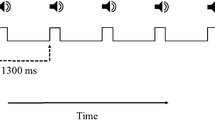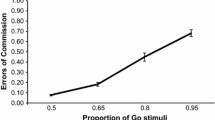Abstract
We examined performance in a sustained attention to response task (SART) (Experiment 1) and a more traditionally formatted vigilance task (Experiment 2) using novel word stimuli (text-speak) and normally spelt words. This enabled us to address whether the SART is a better measure of sustained attention or of response strategy, and to investigate the cognitive demands of text-speak processing. In Experiment 1, 72 participants completed a subset (text-speak) and a word SART, as well as a self-reported text experience questionnaire. Those who reported more proficiency and experience with text-speak made more errors on the subset SART, but this appeared to be due to their increase in response speed. This did not occur in the word SART. In Experiment 2, 14 participants completed high No-Go, low-Go (more traditional response format) versions of these tasks to further investigate the cognitive demands of text-speak processing. Response latency increased over periods of watch only for the text-speak task, not for the word task. The results of Experiment 1 support the perspective that the SART is highly sensitive to response strategy, and the results of both experiments together indicate target detection tasks may be a novel way of investigating the cognitive demands of text-speak processing.



Similar content being viewed by others
References
Baron RM, Kenny DA (1986) The moderator-mediator variable distinction in social psychological research: conceptual, strategic, and statistical considerations. J Pers Soc Psychol 51:1173–1182
Brown TL, Gore CL, Carr TH (2002) Visual attention and word recognition in stroop color naming: is word recognition ‘automatic?’ J Exp Psychol General 131:220–240
Brysbaert M, New B (2009) Moving beyond Kučera and Francis: a critical evaluation of current word frequency norms and the introduction of a new and improved word frequency measure for American English. Behav Res Methods, Instrum Comput 41:977–990
Chan RCK (2001) A further study on the sustained attention response to task (SART): the effect of age, gender and education. Brain Inj 15:819–829
Chan RCK (2002) Attentional deficits in patients with persisting postconcussive complaints: a general deficit or specific component deficit? J Clin Exp Neuropsyc 24:1081–1093
Cheyne JA, Carriere JSA, Smilek D (2009) Absent minds and absent agents: attention-lapse induced alienation of agency. Conscious Cogn 18:481–493
Crystal D (2008) txting the gr8 db8. Oxford University Press, New York
Cummings M (2004) The need for command and control instant message adaptive interfaces: lessons learned from tactical Tomahawk human-in-the-loop simulations. Cyberpsychol Behav 7:653–661
Davies DR, Parasuraman R (1982) The psychology of vigilance. Academic Press, London
Dockree PM, Kelly SP, Roche RA, Hogan MJ, Reilly RB, Robertson IH (2004) Behavioural and physiological impairments of sustained attention after traumatic brain injury. Cogn Brain Res 20:403–414
Dockree PM, Bellgrove MA, O’Keefe FM, Moloney P, Aimola L, Cartoon S, Robertson IH (2006) Sustained attention in traumatic brain injury (tbi) and healthy controls: enhanced sensitivity with dual-task load. Exp Brain Res 168:218–229
Ganushchak L, Krott A, Meyer A (2010) Electroencephalographic responses to SMS shortcuts. Brain Res 1348:120–127
Giambra LM (1995) A laboratory based method for investigating influences on switching attention to task unrelated imagery and thought. Conscious Cogn 4:1–21
Grier RA, Warm JS, Dember WN, Matthews G, Galinsky TL, Szalma JL, Parasuraman R (2003) The vigilance decrement reflects limitations in effortful attention not mindlessness. Hum Factors 45:349–359
Head J, Helton WS, Neumann E, Russell P, Shears C (2011) Text-speak processing. Proc Hum Factors Ergon Soc
Head J, Shears C, Neumann E, Helton WS (2011) Lateralized signal detection. Manuscript submitted for publication
Helton WS (2009) Impulsive responding and the sustained attention to response task. J Clin Exp Neuropsychol 31:39–47
Helton WS, Russell PN (2011) Working memory load and the vigilance decrement. Exp Brain Res 212:429–437
Helton WS, Warm JS (2008) Signal salience and the mindlessness theory of vigilance. Acta Psychol 129:18–25
Helton WS, Dember WN, Warms JS, Matthews G (2000) Optimism, pessimism, and false failure feedback: effects on vigilance performance. Curr Psychol 18:311–325
Helton WS, Hollander TD, Warm JS, Matthews G, Dember WN, Wallart M, Beauchamp G, Parasuraman R, Hancock PA (2005) Signal regularity and the mindlessness model of vigilance. Brit J Psychol 96:249–261
Helton WS, Kern RP, Walker DR (2009) Conscious thought and the sustained attention to response task. Conscious Cogn 18:600–607
Helton WS, Weil L, Middlemiss A, Sawers A (2010) Global interference and spatial uncertainty in the sustained attention to response task (SART). Conscious Cogn 19:77–85
Helton WS, Head J, Russell PN (2011) Reliable- and unreliable-warning cues in the sustained attention to response task. Exp Brain Res 209:401–407
Hitchcock EM, Warm JS, Matthews G, Dember WN, Shear PK, Tripp LD, Mayleben DW, Parasuraman R (2003) Automation cueing modulates cerebral blood flow and vigilance in a simulated air traffic control task. Theoret Issues Ergon Sci 4:89–112
Johnson KA, Kelly SP, Bellgrove MA, Barry E, Cox M, Gill M, Robertson IH (2007) Response variability in attention deficit hyperactivity disorder: evidence for neuropsychological heterogeniety. Neuropsychologia 45:630–638
Johnston WA, Hawley KJ, Plewe SH, Elliott MG, DeWitt MJ (1990) Attention capture by novel stimuli. J Exp Psychol General 119:397–411
Knott B, Bolia R, Nelson T, Galster S (2006) Effects of collaboration technology on the performance of tactical air battle management teams. Proceedings of the Human Factors Issues in Network-Centric Warfare TTCP Symposium
Mackworth NH (1948) The breakdown of vigilance during prolonged visual search. Q J Exp Psychol 1:6–21
Mackworth NH (1950) Researches on the measurement of human performance. Medical Research Council Special Report, No. 2680. London: H.M.S.O. (Reprinted from Selected papers in the design and use of control systems by Sinaiko HW (ed) 1961, Dover, New York, pp 174–331)
Manly T, Robertson IH, Galloway M, Hawkins K (1999) The absent mind: further investigations of sustained attention to response. Neuropsychologia 37:661–670
Manly T, Heutlink J, Davidson B, Gaynord B, Greenfield E, Parr A, Ridgeway V, Robertson IH (2004) An electronic knot in the hankerchief: content free cueing and the maintenance of attentive control. Neuropsychol Rehabil 14:89–116
Matthews G, Davies DR, Westerman SJ, Stammers RB (2000) Human performance: cognition, stress and individual differences. Psychology Press, East Sussex
Matthews G, Warm JS, Reinerman-Jones LE, Langheim LK, Washburn DA, Tripp L (2010) Task engagement, cerebral blood flow velocity, and diagnostic monitoring for sustained attention. J Exp Psychol Appl 16:187–203
O’Connell RG, Bellgrove MA, Dockree PM, Robertson IA (2006) Cognitive remediation in ADHD: effects of periodic non-contingent alerts on sustained attention to response. Neuropsychol Rehabil 16:653–665
Ossowski U, Malinen S, Helton WS (in press) The effects of emotional stimuli on target detection: indirect and direct resource costs. Conscious Cogn
Peebles D, Bothell D (2004) Modelling performance in the sustained attention to response task. In: Proceedings of the sixth international conference on cognitive modelling. Carnegie Mellon University/University of Pittsburgh, Pittsburgh, pp 231–236
Perea M, Gomez P (2010) Does LGHT prime dark? Masked associative priming with addition neighbours. Mem Cognit 38:513–518
Perea M, Acha J, Carreiras M (2009) Eye movements when reading test messaging (txt msgng). Q J Exp Psychol 62:1560–1597
Reilly RG, Radach R (2006) Some empirical tests of an interactive activation model of eye movement control in reading. Cognit Syst Res 7:34–55
Roberston IH, O’Connell RG (2011) Vigilant attention. In: Nobre AC, Coull JT (eds) Attention and time. Oxford University Press, Oxford, pp 79–88
Robertson IH, Manly T, Andrade J, Baddeley BT, Yiend J (1997) ‘‘Oops!’’: performance correlates of everyday attentional failures in traumatic brain injured and normal subjects. Neuropsychologia 35:747–758
Salvucci DD (2001) An integrated model of eye movements and visual encoding. Cognit Syst Res 1:201–220
Schneider W, Eshman A, Zuccolotto A (2002) E-prime 2.0 user’s guide. Psychology Software Tools. Inc, Pittsburgh
See JE, Howe SR, Warm JS, Dember WN (1995) A meta-analysis of the sensitivity decrement in vigilance. Psychol Bull 117:230–249
Shaw TH, Warm JS, Finomore V, Tripp L, Matthews G, Weiler E, Parasuraman R (2009) Effects of sensory modality on cerebral blood flow velocity during vigilance. Neurosci Lett 461:207–211
Smallwood J, Schooler JW (2006) The restless mind. Psychol Bull 132:946–958
Smallwood J, Baracaia SF, Lowe M, Obonsawin MC (2003) Task unrelated-thought whilst encoding information. Conscious Cogn 12:452–484
Smallwood J, Davies JB, Heim D, Finnigan F, Sudberry M, O’Conner R, Obonsawin M (2004) Subjective experience and the attentional lapse: task engagement and disengagement during sustained attention. Conscious Cogn 13:657–690
Stroop JR (1935) Studies of interference in serial verbal reactions. J Exp Psychol 18:643–662
Teichner WH (1974) The detection of a simple visual signal as a function of time on watch. Hum Factors 16:339–353
Temple JG, Warm JS, Dember WN, Jones KS, LaGrange CM, Matthews G (2000) The effects of signal salience and caffeine on performance, workload and stress in an abbreviated vigilance task. Hum Factors 42:183–194
Thurlow C (2003) Generation txt? The sociolinguistics of young people’s text-messaging. Discourse Analysis Online 1
Turkoski B (2009) Improving patient safety by improving medication communication. Orthopaedic Nursing 28:150–152
Warm JS (1984) An introduction to vigilance. In: Warm JS (ed) Sustained attention in human performance. Wiley, Chichester, pp 1–14
Warm JS (1993) Vigilance and target detection. In: Huey BM, Wickens CD (eds) Workload transitions: implications for individual and team performance. National Academy Press, Washington, pp 139–170
Warm JS, Parasuraman R, Matthews G (2008) Vigilance requires hard mental work and is stressful. Hum Factors 50:433–441
Weissman DH, Roberts KC, Visscher KM, Woldorff MG (2004) The neural bases of momentary lapses of attention. Nat Neurosci 9:971–978
Wiener EL (1987) Application of vigilance research: rare, medium or well done? Hum Factors 87:725–736
Author information
Authors and Affiliations
Corresponding author
Rights and permissions
About this article
Cite this article
Head, J., Russell, P.N., Dorahy, M.J. et al. Text-speak processing and the sustained attention to response task. Exp Brain Res 216, 103–111 (2012). https://doi.org/10.1007/s00221-011-2914-6
Received:
Accepted:
Published:
Issue Date:
DOI: https://doi.org/10.1007/s00221-011-2914-6




